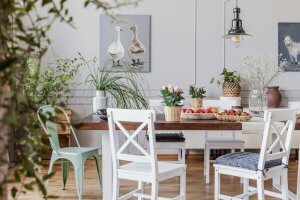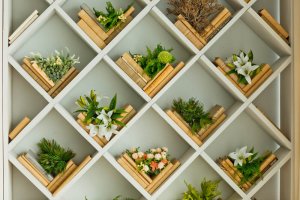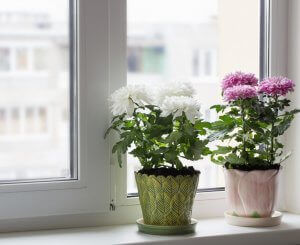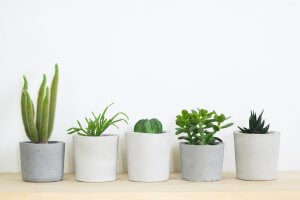Tips for Arranging Your Plants Around Your Home

Correctly arranging your plants around your home is an art. The type of flowerpots and plants you have determines how you’ll arrange them in their designated space.
The shape, size, and layout of your plants will give them a certain decorative value. Take note, because we’re going to give you some tips on how you can arrange your plants around your home.
The art of arranging your plants

Plants and flowerpots can be arranged in a line, or grouped by size and shape, depending on your home’s decorative needs.
By repetition
Grouping certain elements together (size and shape of the flower pot, size, and species of the plant) will make your home feel abundant. You can apply this layout to areas of your home where the lack of space isn’t conducive to housing different plant species.
Alternating patterns
You can alternate between a selection of flowerpots made from the same material and plants of the same species. The flowerpots can be different shapes and the plants can vary in length. This transmits movement and brings energy to the more spacious rooms.
In a row
Arranging a group of identical flowerpots in a row lengthens the view of a short wall. You can also define two different areas of the same room.
Keep in mind that the size of the flowerpots you plan to use and the size and species of the plants must be proportionate to the available space.
Size and color

By knowing the size of the flowerpot and shape of the plant, you can create decorative elements of great effect. You can use either a single flowerpot or group several of them together.
Try placing three plants against the wall, two tall ones in the back and a short one in the front. Arrange the plants into a triangular form, and you’ll see how the sensation of variety and movement will be transmitted. On the contrary, if you choose only one plant and flowerpot, both with a rounded shape, it will be too static and simple.
We advise you to play around with the color of the flowerpot, the foliage, and the flowering of the plant. Look at how the light reflects off the leaves and how the foliage creates different shades.
The impact of the contrasting color combinations of green foliage with the tones of the flower blossoms of other plants is accentuated by grouping different types of plants in a single flowerpot.
Having more than one color and texture of leaves and flowers in the flowerpot makes the combination more versatile. This can be used decoratively in places where only one flowerpot fits.
Don’t forget that the combinations of flowers or flowerpots that you use should match the decorations in each room of your house.
Symmetry and repetition

Did you know that the same size flowerpot and shape of plant creates a symmetrical effect that allows for decorative variations? Keep this in the back of your mind, as it will be very useful.
Try arranging several plants in a row on a windowsill so they can be seen from both inside and outside. We also recommend grouping them on a table or arranging them on a shelf.
Repeating the color and type of plant from various flowerpots with varying shapes and sizes is an original way to arrange the plants. Especially if we transfer the concept of repetition to the plant.
Using the same species, with foliage in shades that are similar to the color of the pots but in different stages of growth, unifies a place in a room where the same tone prevails in the furniture.
If you arrange plants in front of a mirror, the effect multiplies. This transmits a feeling of abundance in such a small space.
Another way to emphasize the shapes and sizes of flowerpots and plants is to arrange them at different heights in relation to the plant’s size.
And don’t forget…

Bringing together plants from similar climates or habitats allows you to reflect the original environment of the plants. This is ideal if you want to recreate gardens of a certain style.
Arrange flowerpots with plants of the same species and color and different shapes to give your room a casual touch. Rearranging a group of plants as they grow preserves the original idea of the combination. All you have to do is move around the larger plants.
What do you think of our tips?
Correctly arranging your plants around your home is an art. The type of flowerpots and plants you have determines how you’ll arrange them in their designated space.
The shape, size, and layout of your plants will give them a certain decorative value. Take note, because we’re going to give you some tips on how you can arrange your plants around your home.
The art of arranging your plants

Plants and flowerpots can be arranged in a line, or grouped by size and shape, depending on your home’s decorative needs.
By repetition
Grouping certain elements together (size and shape of the flower pot, size, and species of the plant) will make your home feel abundant. You can apply this layout to areas of your home where the lack of space isn’t conducive to housing different plant species.
Alternating patterns
You can alternate between a selection of flowerpots made from the same material and plants of the same species. The flowerpots can be different shapes and the plants can vary in length. This transmits movement and brings energy to the more spacious rooms.
In a row
Arranging a group of identical flowerpots in a row lengthens the view of a short wall. You can also define two different areas of the same room.
Keep in mind that the size of the flowerpots you plan to use and the size and species of the plants must be proportionate to the available space.
Size and color

By knowing the size of the flowerpot and shape of the plant, you can create decorative elements of great effect. You can use either a single flowerpot or group several of them together.
Try placing three plants against the wall, two tall ones in the back and a short one in the front. Arrange the plants into a triangular form, and you’ll see how the sensation of variety and movement will be transmitted. On the contrary, if you choose only one plant and flowerpot, both with a rounded shape, it will be too static and simple.
We advise you to play around with the color of the flowerpot, the foliage, and the flowering of the plant. Look at how the light reflects off the leaves and how the foliage creates different shades.
The impact of the contrasting color combinations of green foliage with the tones of the flower blossoms of other plants is accentuated by grouping different types of plants in a single flowerpot.
Having more than one color and texture of leaves and flowers in the flowerpot makes the combination more versatile. This can be used decoratively in places where only one flowerpot fits.
Don’t forget that the combinations of flowers or flowerpots that you use should match the decorations in each room of your house.
Symmetry and repetition

Did you know that the same size flowerpot and shape of plant creates a symmetrical effect that allows for decorative variations? Keep this in the back of your mind, as it will be very useful.
Try arranging several plants in a row on a windowsill so they can be seen from both inside and outside. We also recommend grouping them on a table or arranging them on a shelf.
Repeating the color and type of plant from various flowerpots with varying shapes and sizes is an original way to arrange the plants. Especially if we transfer the concept of repetition to the plant.
Using the same species, with foliage in shades that are similar to the color of the pots but in different stages of growth, unifies a place in a room where the same tone prevails in the furniture.
If you arrange plants in front of a mirror, the effect multiplies. This transmits a feeling of abundance in such a small space.
Another way to emphasize the shapes and sizes of flowerpots and plants is to arrange them at different heights in relation to the plant’s size.
And don’t forget…

Bringing together plants from similar climates or habitats allows you to reflect the original environment of the plants. This is ideal if you want to recreate gardens of a certain style.
Arrange flowerpots with plants of the same species and color and different shapes to give your room a casual touch. Rearranging a group of plants as they grow preserves the original idea of the combination. All you have to do is move around the larger plants.
What do you think of our tips?







